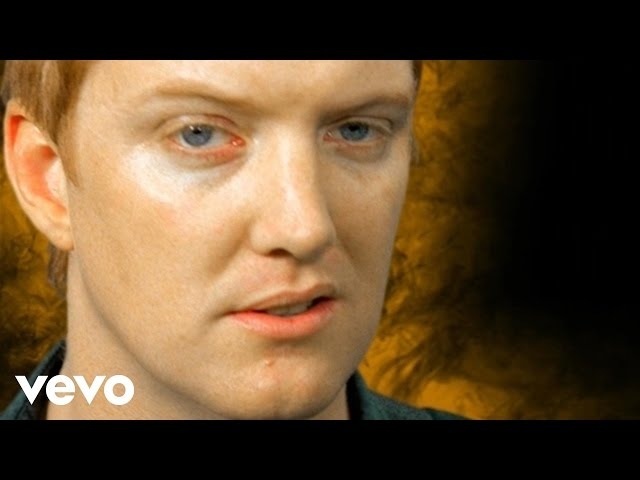Where to start with the tuneful heaviness of Josh Homme

Geek obsession: Josh Homme
Why it’s daunting: Singer-guitarist Josh Homme has written some of the most accessible—if not downright catchiest—heavy-rock songs of the past three decades. And with the recent release of …Like Clockwork, the sixth album by his current band Queens Of The Stone Age, he’s still firing on all cylinders. But Homme remains one step short of being a household name. In spite of his massive hooks, superstar swagger, and association with Dave Grohl (QOTSA’s occasional drummer), he remains one of the biggest cult artists around. That’s not a bad place to be; in addition to his cred-establishing back catalog as the guitarist of stoner-rock titan Kyuss, Homme fronts the project Them Crooked Vultures alongside Grohl and Led Zeppelin’s John Paul Jones. There’s a subversive, and at times perverted, streak to Homme’s songs that keeps them squarely left of the mainstream—and a rabid fan base that’s more outspoken about Homme’s music than Homme himself.
Possible gateway: Queens Of The Stone Age, Songs For The Deaf
Why: With its choppy, slinky anthems and stadium-sized choruses, QOTSA is Homme’s most friendly band to newcomers. And its third album, 2002’s Songs For The Deaf, is its most immediately captivating. Aided by Grohl and founding bassist Nick Oliveri—a veteran of Kyuss who left after Songs and just recently made a tentative return to the fold as a guest on Clockwork—the album is a tightly packed bundle of tough, lean pop-rock delivered with a leering wink. It also contains QOTSA’s most recognizable hit, “No One Knows,” a jerky, Franz Ferdinand-meets-classic-rock earworm that has yet to wear out its welcome. Homme’s Anglophile tendencies pop up throughout his career, from the Sabbathian slant of Kyuss to the Queen-like stomp of QOTSA to his ongoing love affair with Arctic Monkeys (displayed most recently on Clockwork, which features a guest appearance by Arctic Monkeys frontman Alex Turner). But Homme’s music is also deeply rooted in his natural habitat: the Mojave Desert of California, which he references often (including on “No One Knows”). But rather than trying to craft some kind of sonic metaphor for the desert, QOTSA funnels the boredom, isolation, and underdog spirit of growing up in small-town, middle-of-nowhere, sandblasted America.
Next steps: The two albums that precede Songs For The Deaf—QOTSA’s self-titled debut from 1998 and Rated R from 2000—are also indispensable slabs of prime Homme. As the next logical steps in QOTSA immersion, they’re more or less as irresistible as Songs. With its fuzz-clogged riffs and vestiges of Kyuss-esque enormity, Queens Of The Stone Age grinds away with punky, near adolescent abandon. Rated R is a slightly less unhinged affair, with Homme’s burgeoning songcraft starting to take center stage. Between the two of them, the albums nail down every element that QOTSA would go on to explore—even if Clockwork, 2005’s Lullabies To Paralyze, and 2007’s Era Vulgaris are better to explore after getting a grounding in the basics of Homme’s idiosyncratic rock vernacular.
The mighty Kyuss—named after a creature from Dungeons & Dragons—is as monstrously, magically majestic as a late-night RPG session in your mom’s basement. The garage-spawned stoner rock of the group’s second album, 1992’s Blues For The Red Sun, is a solid entry point into that early stage of Homme’s evolution. That said, Kyuss is killer, and in many ways the band is equal to—yet different than—QOTSA. Homme played guitar in Kyuss, but was neither the singer nor the lone songwriter. Yet there’s a cohesion to Blues For The Red Sun that fits beautifully between the howling blues-metal of Kyuss’ debut, 1991’s Wretch, and the more melodic elements the group would incorporate before disbanding in 1995. While grunge was dying and nü-metal was being born, Kyuss offered an equally heavy yet far more timeless alternative.
Where not to start: Driving home the affinity Homme still feels for his Mojave roots, he sporadically heads up the long-running, ever-rotating collective known as The Desert Sessions. The group’s various recordings—1997’s Volume 1: Instrumental Driving Music For Felons through 2003’s Volume 10: I Heart Disco—have featured a staggering roll call of artists. PJ Harvey, Dean Ween, as well as members of Nine Inch Nails, Soundgarden, and Marilyn Manson (among many others) have joined Homme at one time or another to hole up in his Rancho De La Luna studio in Joshua Tree to drink, trip, and follow the muse down the rabbit hole. A frequent contributor to The Desert Sessions is Screaming Trees singer Mark Lanegan, who also lends his whiskey-charred voice to QOTSA on occasion. Those 10 volumes (and counting, at least according to Homme) are full of freewheeling jams and detours, some of which wind up being the seeds for future QOTSA songs. But those looking to dig into Homme’s music should save The Desert Sessions—as well as the raucous garage-rock of his side-project Eagles Of Death Metal and the lumbering boogie of Them Crooked Vultures—for dessert.